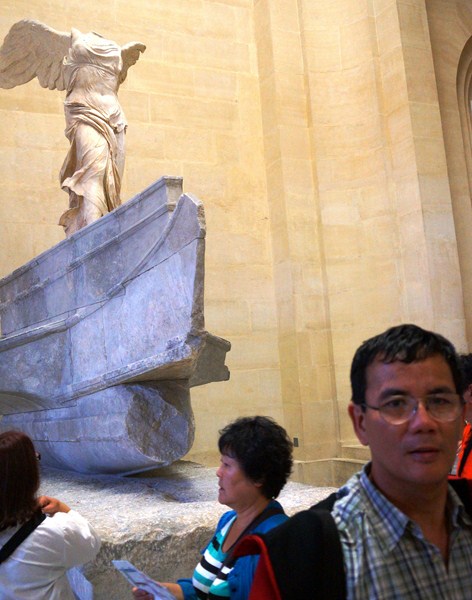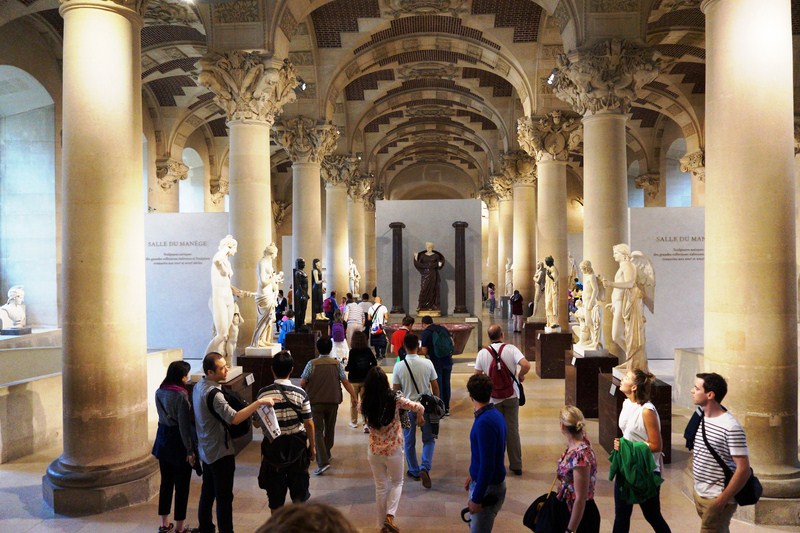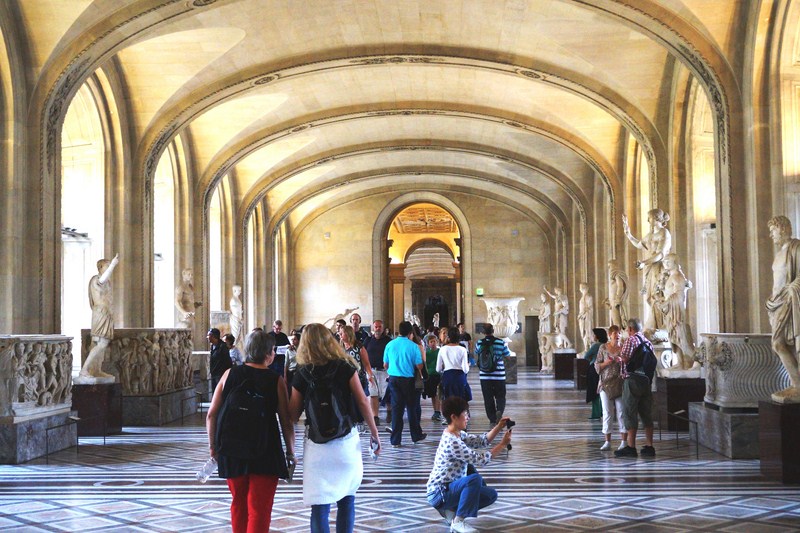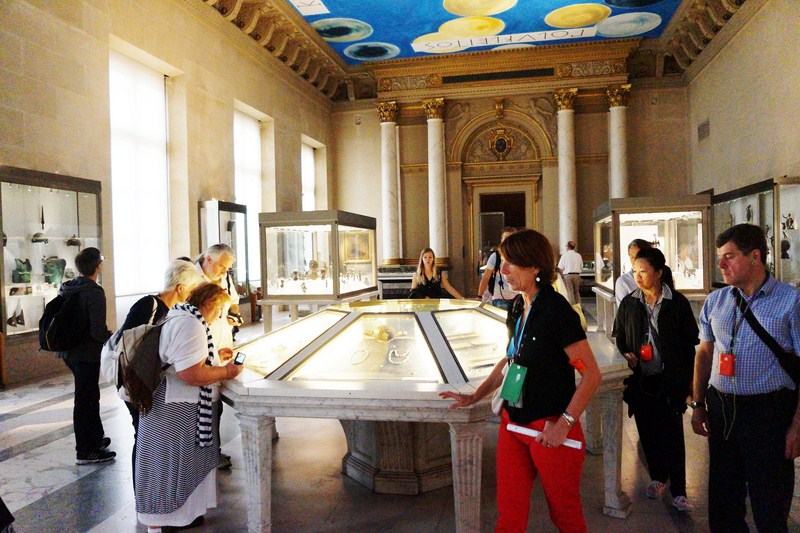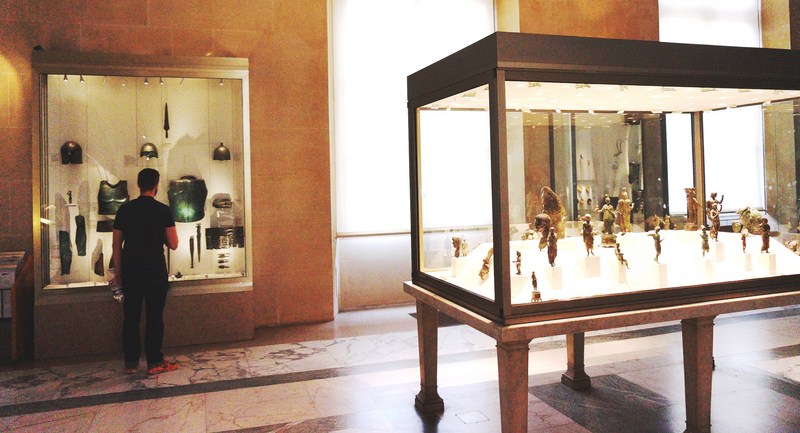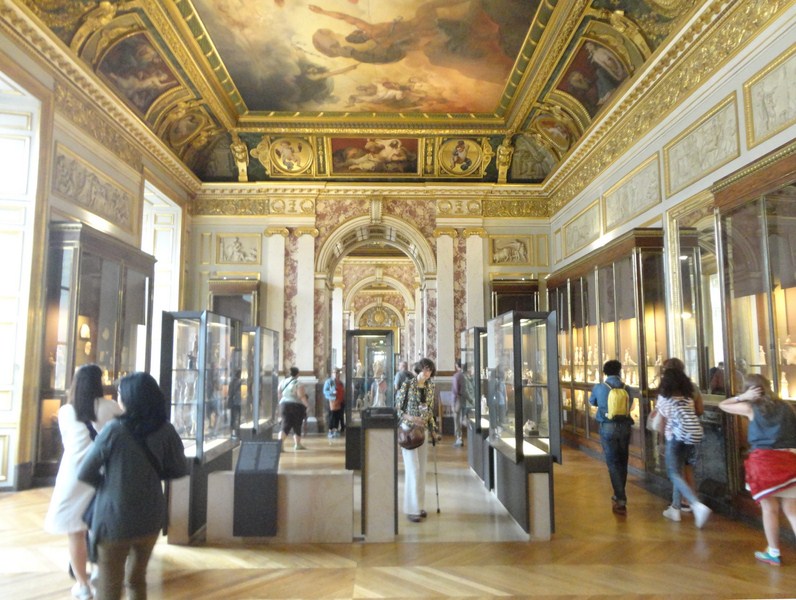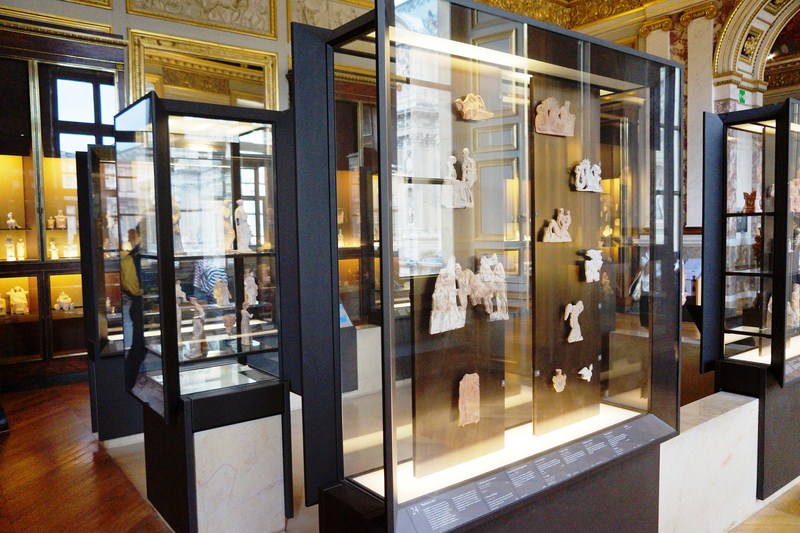The Department of Greek, Etruscan and Roman Antiquities, one of the museum’s oldest, is home to a collection of artworks representing the Greek, Etruscan, and Roman civilizations, spanning from the Cycladic Period to the decline of the Roman Empire.
Check out “Louvre Museum”
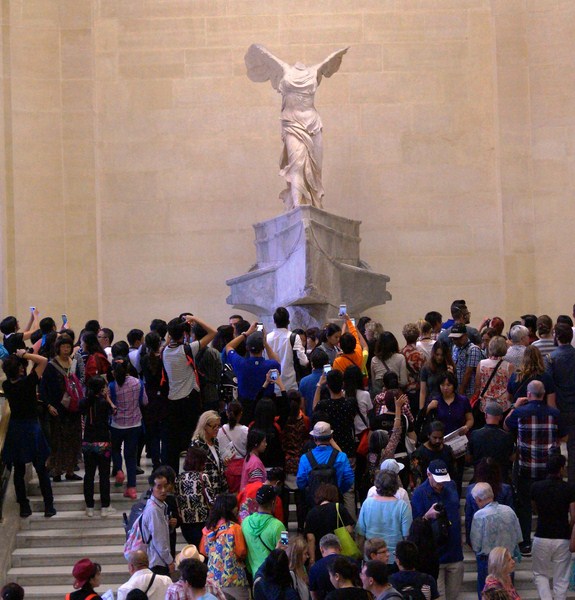
Crowds gathered in front of the ca. 190 BC Winged Victory of Samothrace, a magnificent Hellenistic statue that may have commemorated a naval victory, possibly by a fleet from Rhodes in the 2nd century BC. Excavations on the island of Samothrace, where it was found in 1863, revealed that it originally stood on the prow of a grey marble ship, at the center of an ornamental fountain. It depicts the winged Hellenistic goddess Nike. During World War II, this masterpiece, along with the Mona Lisa, Slaves by Michelangelo and the Venus de Milo sculpture were shifted to Château de Valençay.
The best artists from the reign of Charles X (Jean-Auguste-Dominique ngres, Vernet, Fragonard, etc.) amazingly combined palace décor from 1827 with antiquities collections to evoke Homer, Pompeii and Herculaneum. The Winged Victory of Samothrace welcomed Jandy and I as well as other visitors, dazzling us with its triumphant silhouette, as we appreciated its size from the top of the steps of the Daru staircase.
The exhibits, housed on the first floor of the Denon Wing (part of it also seen on the mezzanine) and part of the Sully Wing, are themed and chronological, with the Greek works separated from the Roman and Etruscan antiquities.
Here’s the historical timeline of the museum:
- In 1793, the department was formed around the appropriated former royal art collections (some of which was acquired under Francis I), initially focused on marble sculptures.
- During the French Revolution, it was further enriched by property seized
- During the Napoleonic Wars, works such as the Apollo Belvedere
- In 1800, the museum was installed in the summer apartments of Anne of Austria.
- In the 19th century, works including vases from the Durand collection and bronzes such as the Borghese Vase from the Bibliothèque Nationale, were acquired by the Louvre.
- In 1807, the purchase of over five hundred marble sculptures from the Borghese collection required the refurbishment of the Salle des Cariatides, the ground floor of the Pavillon du Roi, and the queen’s winter apartments.
- In 1815, after the return of the works to Italy (including the Apollo Belvedere), Ennio Quirino Visconti (1751-1818), the Louvre’s first curator of antiquities, adopted an active acquisitions policy.
- In 1818, the Tochon collection was purchased enriching, with archaeological objects, the Louvre’s collection which mostly comprised of marble sculptures. This was followed by that of Durand (1825-1836).
- In 1821, the Venus de Milo (a sculpture of Aphrodite with her arms missing discovered on the Greek island of Milos, in the Cyclades Archipelago) entered the museum. It was first offered to Louis XVIII by the Marquis de Rivière, after which the monarchy donated it to the Louvre.
- in 1827, the Musée Charles X, on the first floor of the Louvre palace, was opened.
- In 1861, when the Campana collection was acquired, its vases were installed on the first floor of the Cour Carrée’s south wing, in a gallery parallel to the Musée Charles X.
- During the second half of the 19th century, as a result of archaeological expeditions, the museum acquired many objects from North Africa and the Ottoman Empire.
- In 1884, The Winged Victory of Samothrace, discovered by Champoiseau in 1863, was placed at the top of the Daru staircase. Ancient Greek sculpture then came to the fore with the Kore of Samos, the Rampin Head, the Lady of Auxerre, and the Tanagra figurines of Boeotia.
- In the early 20th century, it was decided to renovate the department completely, and this project was carried out in various stages.
- In 1934, the museum of sculpture inaugurated by Napoleon was dismantled, and chronological classification was established. A section devoted to Greek art, centered on the sculptures in the queen’s winter apartments, the Salle de Diane, and the Salle des Cariatides, was opened on the ground floor; and a Roman art section was created around the former summer apartments of Anne of Austria.
- In the postwar period, the first floor was reorganized. Bronzes were displayed in the Salle Lacaze, Etruscan art in the Salle Henri II, and Roman silverware and frescoes in the Salle des Bijoux.
- In 1980, an ambitious reorganization plan was initiated resulting in the present arrangement of the department. The Etruscan collections were displayed on the ground floor (between the Cour du Sphinx and the Petite Galerie), and Roman sculptures moved to the Petite Galerie and the Salle d’Auguste.
- In the 1990s, after the inauguration of the Louvre pyramid, a new organizational project was launched, initially concerning the Greek art collection and the first-floor rooms (1997-2010).
- In 1997, the Pre-Classical Greek gallery opened, supplemented by a gallery dedicated to Greek epigraphy, a room representing the Severe style, and a new room (under the Winged Victory staircase) devoted to the Temple of Zeus at Olympia. As a result, a new entrance to the department was created, combining artworks representing a wide range of materials and techniques.
- The same year saw other changes, with the renovation of the Galerie Daru, and the refurbishment of the first floor: silverware was moved to the Salle Henri II, glassware to the former jewelry room, terracotta figurines and reliefs took over half the former Musée Charles X, and the bronze room and Galerie Campana were fully renovated.
- In 2004, the Salle du Manège was opened That same year, a remarkable life-sized horse’s head, a fragment from an Archaic Greek sculpture dating from the 6th century BC., was acquired.
In 2006, the Salle de Diane was rearranged to display the Parthenon marbles. - In July 2010, the renovation of the Greek art section was finalized with the opening of rooms dedicated to classical Greek and Hellenistic art, and a new home for the Venus de Milo.
The department illustrates the art of a vast area encompassing Greece, Italy, and the whole of the Mediterranean Basin, and spans the period from Neolithic times (4th millennium BC) to the 6th century.
The Louvre collection counts 2700 vases on display in new and elegant showcases. It includes a large number of Greek vases of all shapes such as amphora, krater, hydria, long shaped lekythos, cups and some interesting rythons with a head of a donkey. In Room 43 is a unique oenochoe (wine jug) in the form of a head from a black slave.
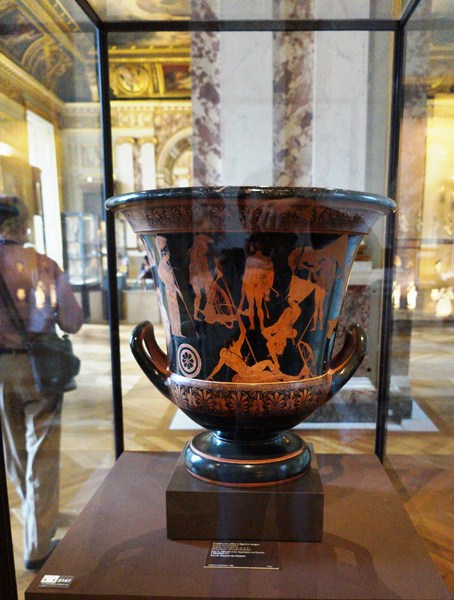
Niobid Krater. Ca. 470 to 450 BC., it shows the god Apollo and his sister Artemis killing the children of Niobe who were collectively called the Niobids.
Masterpieces from the Hellenistic Era include the Winged Victory of Samothrace (190 BC) and the Venus de Milo (Room 16 on the ground floor of the Pavillon du Roi, presented to Louis XVIII by the Marquis de Rivière in 1821), symbolic of Classical art. The latter, the highlight of the museum, stands at the staircase linking the Denon and Sully wings.
Jewelry and pieces, such as the limestone Lady of Auxerre (from 640 BC) and the cylindrical Hera of Samos (circa 570–560 BC.), demonstrate the archaic.
The Galerie Daru (Room 406), which formed part of Napoleon III’s “New Louvre,” was originally intended as a sculpture gallery for the annual Paris Salon. It now displays Greek and Roman antiquities, notably the celebrated Borghese Gladiator which exemplifies increased focus on the human form after the 4th century BC.
Check out “Louvre Museum – Daru Gallery“
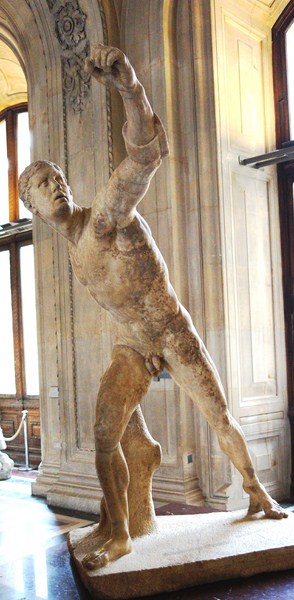
Borghese Gladiator (Daru Gallery), created at Ephesus about 100 BC, is a life-size, Hellenistic marble sculpture portraying a swordsman.
An outstanding collection of more than one thousand Greek potteries are displayed at the long Galerie Campana.
Roman Art (Julio-Claudian Period I, Between 1655 and 1658), at Room 410, Ground Floor, Denon Wing, houses the Roman Department. Louis Le Vau transformed Anne of Austria’s summer apartments. The new decoration featured paintings by Giovanni Francesco Romanelli and stucco work by sculptor Michel Angier. The apartments became a gallery of antiquities in 1799.
Paralleling the Seine River are galleries that display much of the museum’s Roman sculpture. Roman portraiture, representative of that genre, include the portraits of Agrippa and Annius Verus. Among the bronzes is the Greek Apollo of Piombino.
The Bronze Room (Salle des Bronzes, Room 32, 1st Floor, Sully Wing), built between 1551 and 1553 by the architect Pierre Lescot, was designed as the centerpiece of the 16th-century additions to the Louvre.
Between 1936 and 1938, it was transformed by Albert Ferran and the gallery now houses the museum’s collection of more than 1,000 pieces of ancient art created from bronze (helmets, Hellenic rings, the crown of laurel in gold, etc.), as well as other precious metals.
Standing out is Cy Twombly’s 344 sq. m. (3700 sq. ft.) ceiling mural created in 2010. Alongside German Anselm Kiefer and Frenchman Francois Morellet, Twombly is the third artist and the first American to ever paint a permanent modern decorative work for the Louvre. Along the edges are white strips that contain the names (in Greek) of seven renowned Greek sculptors from the Classic period.
The first-floor Salle des Sept Cheminées, formerly the King’s chamber (above the Venus de Milo room), is devoted to Italic and Etruscan art.
The completely refurbished Rooms 7-17 (open to the public since July 7, 2010), at the Sully Wing, are devoted to the classical Greek and Hellenistic art while Rooms 35 – 37 (Musée Charles X) displays Greek terracotta figurines arranged chronologically, geographically and thematically.
Check out “Charles X Museum“
The terracotta figures (“Tanagra figurines”) date from the Archaic, Pre-Classical Hellenistic and Roman periods. It includes the small and quite elegant “Victory with Wings” (from 190 BC.).
The Salle des Caryatids, at Room 348, is located on the ground floor of Pierre Lescot’s 16th-century Renaissance wing. This room takes its name from the four female figures sculpted by Jean Goujon in 1550 to support the musicians’ gallery. Today, it houses Roman copies of Greek originals long since disappeared.
Louvre Museum: 75001 Paris, France. Tel: +33 1 40 20 50 50. Open daily, except Tuesdays and holidays, 9 AM- 6 PM (until 10 PM on Wednesday and Friday evenings).
The Louvre has three entrances: the main entrance at the pyramid, an entrance from the Carrousel du Louvre underground shopping mall, and an entrance at the Porte des Lions (near the western end of the Denon wing).
Admission is free, from October to March, on the first Sunday of every month. Still and video photography is permitted for private, noncommercial use only in the galleries housing the permanent collection.The use of flash or other means of artificial lighting is prohibited. Photography and filming are not permitted in the temporary exhibition galleries.
How To Get There: the Louvre can be reached via Metro lines 1 and 7, station Palais Royal – Musée du Louvre Métro or the Louvre-Rivoli stations. By bus, take No. 21, 24, 27, 39, 48, 68, 69, 72, 81, 95 as well as the touristic Paris l’Open Tour. By car, there is an underground parking reachable by Avenue du Général Lemonier, every day from 7 AM – 11 PM.

